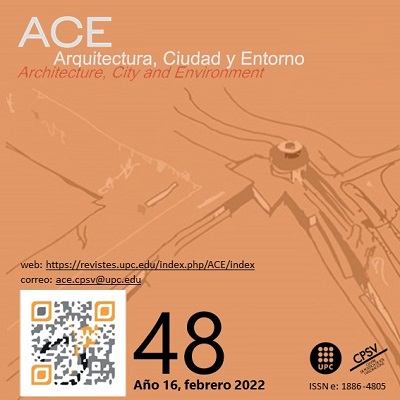Manuel Spínola's Plan for the Urban Configuration of Écija in 1826
DOI:
https://doi.org/10.5821/ace.16.48.10378Keywords:
Andalusian medium-sized cities, urban carthography, urban planning tool, 19th centuryAbstract
Urban cartography in the Spanish 19th century rose during the French occupation and the arrival of the Enlightenment. The maps became instruments that allowed for better city governance. Later, in the reign of Isabel II, the Royal Order of 1846 had as its main objective to establish the control of urban transformations in the main cities of the country through urban cartography. This required a high-plan production by the municipalities themselves, together with the work of cartographers and engineers. In the province of Seville, the cartographer Manuel Spínola de Quintana, worked on seven Andalusian towns, where Écija is one of them. Its plan is possibly the oldest in the city, dating from 1826. It is also the first to represent its urban periphery. It is an unpublished document of great planimetric quality due to its graphics and colouring, as well as its description of the city. A comparison is made with three other contemporary plans of Écija, with a detailed analysis, using Spínola’s plan as the main source. The comparative analysis has produced interesting results, such as a more accurate dating of one of the known plans, as well as evidence of the primacy of Spínola’s document. Finally, a detailed analysis makes it possible to appreciate the configuration of Écija at the beginning of the century, a key factor in future town planning. This is done through the elements of the urban area (parishes, convents, monasteries, squares, etc.), as well as those in its immediate surroundings (roads, farmlands, infrastructures, etc.)
Published
Issue
Section
License
| INTELECTUAL PROTECTION CRITERIA |
At this moment, it is count with the "Oficina Española de Patentes y Marcas", while global protection it is being processed by the World Intelectual Property Organization (OMPI/WIPO). Nevertheless the International Standard Serial Number Office (ISSN) has given the following numbers ISSN: 1886-4805 (electronic version) and 1887-7052 (paper version). All articles will be peer reviewed, using double blind reviewing. |
| COPYRIGHT |
The article contents and their comments are authors exclusive liability, and do not reflect necessarily the journal editor commitee's opinion. All ACE published works are subject to the following licence CC BY-NC-ND 3.0 ES http://creativecommons.org/licenses/by-nc-nd/3.0/es/ It implies that authors do not hold nor retain the copyright without restrictions but only those included in the licence. |


































